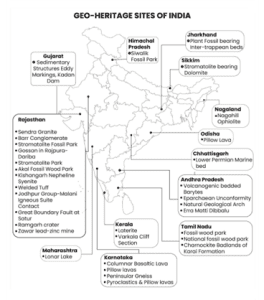TAG: GS-1: HISTORY
CONTEXT: On 29 Sep 2024, the Central government said that the names of 10 geological sites sent to the Archaeological Survey of India (ASI) for inclusion in the list of World Heritage Sites were under scrutiny.
EXPLANATION:
Why in News?
The Geological Survey of India (GSI) recently identified ten geological sites in India. India lacks legislative protection for heritage sites, but the Geoheritage Sites and Georemains Bill, 2022 aims to provide legal protection.
1. Lonar Crater, Maharashtra: A large impact crater formed by a meteorite strike, offering insights into Earth’s early history.
-
- Lonar Crater sits inside the Deccan Plateau – a massive plain of volcanic basalt rock created by eruptions some 65 million years ago. Its location in this basalt field suggested to some geologists that it was a volcanic crater.
2. Bhedaghat, Madhya Pradesh: Known for its marble formations and the Dhuandhar Falls, a popular tourist destination.
-
- Bhedaghat, often referred to as the Grand Canyon of India, is a town in the Jabalpur district of Madhya Pradesh (India), around 25 kms from Jabalpur
3. Gandikota Gorge, Andhra Pradesh: A canyon carved by the Penna River, showcasing erosion and sedimentation processes.
-
- It’s located on the right bank of the Pennar river, 15 km from Jammalamadugu. Gandikota is known for its historical fort and the canyon formed by the Pennar river cutting through the Erramala Hills.
4. Kutch Desert, Gujarat: A unique desert landscape with salt pans, dunes, and wildlife habitats.
-
- The bulk of fossils unearthed in Kutch have so far been mainly marine organisms, due to their proximity to the Arabian Sea. Geological changes eventually closed off the salt-flats’ connection to the sea and the region turned into a large lake, eventually becoming salty wetlands.
- It points to clues on how mammals dispersed between Africa and the Indian subcontinent when part of India was in the Gondwanaland supercontinent that existed nearly 300 million years ago.
5. Western Ghats, Karnataka, Kerala, and Tamil Nadu: A UNESCO World Heritage Site known for its biodiversity and geological formations.
6. Deccan Traps, Central India: A large volcanic plateau with basaltic lava flows, providing evidence of past volcanic activity.
-
- The Deccan Traps are a volcanic province in west-central India that covers almost 200,000 square miles.
- They are made up of basalt lava flows that erupted over a period of 600,000–800,000 years, between 66.3–65.6 million years ago.
- The Deccan Traps are a volcanic province in west-central India that covers almost 200,000 square miles.
7. Himalayas, Uttarakhand, Himachal Pradesh, Sikkim, and Arunachal Pradesh: The world’s highest mountain range, showcasing tectonic plate movements and glacial erosion.
8. Rann of Kutch, Gujarat: A salt marsh ecosystem with unique geological features and biodiversity.
9. Pamban Island, Tamil Nadu: An island formed by sand dunes and coral reefs, offering insights into coastal processes.
10. Hampi, Karnataka: A UNESCO World Heritage Site known for its historical ruins and geological formations.
-
- The Archaeological Survey of India (ASI) for consideration as World Heritage Sites is a significant step towards preserving and promoting the country’s rich geological heritage.
- Earlier, the GSI identified certain geological sites across the Southeast for promotion of geo-tourism.
- The Archaeological Survey of India (ASI) for consideration as World Heritage Sites is a significant step towards preserving and promoting the country’s rich geological heritage.
What are the Key Points:
- These sites represent millions of years of Earth’s history and offer invaluable insights into the planet’s formation and evolution.
- This would not only enhance India’s global reputation as a country with a rich geological heritage but also contribute to the conservation of some of the most remarkable geological formations on Earth.
- The fact that there are approximately 100 geo-heritage sites in India, of which 32 have been recognized as National Geological Monuments, underscores the country’s diverse and unique geological landscape.
What are Geo-heritage Sites?
- Geo-heritage refers to the geological features which are inherently or culturally significant offering insight to earth’s evolution or history to earth science or that can be utilized for education.
- Geological Survey of India (GSI) is the parent body which is making efforts towards identification and protection of geo-heritage sites/national geological monuments in the country.
- There are currently 213 UNESCO Global Geoparks in 48 countries, but none in India.

Source:
Spread the Word
